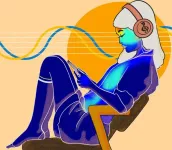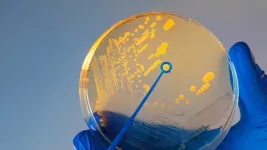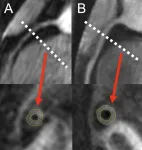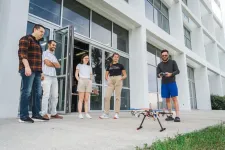(Press-News.org) An astrophysicist from The University of Texas at Dallas and his colleagues from the Dark Energy Spectroscopic Instrument (DESI) collaboration are at the forefront of an ambitious experiment to study the expansion of the universe and its acceleration.
Dr. Mustapha Ishak-Boushaki, professor of physics in the School of Natural Sciences and Mathematics (NSM) at UT Dallas, is a member of the DESI collaboration, an international group of more than 900 researchers from over 70 institutions around the world engaged in a multiyear experiment to increase understanding of the history and fate of the cosmos.
On April 4, Ishak-Boushaki presented analyses of the first year of data collected by the DESI experiment at a meeting of the American Physical Society in Sacramento, California, along with two other DESI scientists. Ishak-Boushaki presented the cosmology results inferred from DESI data and their implications for the universe. Researchers also shared results from the first year of collected data in multiple papers posted on the preprint site arXiv.
The DESI instrument, located at Kitt Peak National Observatory (KPNO) in Arizona, gathers light from the most distant parts of the universe, which enables scientists to map the cosmos as it was in its youth and trace its evolution to what is observed today. Understanding how the universe has evolved is tied to how it ends and to one of the biggest mysteries in physics: What is behind the observation that the expansion of the universe is accelerating?
The analysis of DESI’s first year of data collection confirmed the basics of what scientists hold as the best model of the universe, but it also hints that there is more to learn about the underlying cause, or causes, of cosmic acceleration, the discovery of which led to the Nobel Prize in physics in 2011.
Cosmic acceleration is problematic because it counters how gravity, which causes objects with mass to be drawn together, is observed to work in our solar system and nearby space.
“Gravity pulls matter together, so that when we throw a ball in the air, the Earth’s gravity pulls it down toward the planet,” Ishak-Boushaki said. “But at the largest scales, the universe acts differently. It’s acting like there is something repulsive pushing the universe apart and accelerating its expansion. This is a big mystery, and we are investigating it on several fronts. Is it an unknown dark energy in the universe, or is it a modification of Albert Einstein’s theory of gravity at cosmological scales?”
Dark energy is thought by many scientists to play a key role in cosmic acceleration, but it is not well understood. Some theorize that it is a cosmological constant – an intrinsic property of space that drives the acceleration.
To study dark energy’s effects over the past 11 billion years, the DESI group has created the largest 3D map of the cosmos ever constructed using the most precise measurements to date. This is the first time scientists have measured the expansion history of the young universe with a precision better than 1%.
The leading model of the universe is known as Lambda-CDM. It includes both ordinary matter and a rarely interacting type of matter called cold dark matter (CDM) and dark energy, known as Lambda. Both matter and dark energy shape how the universe expands, but in opposing ways. Through gravitational attraction, matter and dark matter slow down the expansion, while dark energy speeds it up. The amount of each influences how the universe evolves. This model is effective at validating results from previous experiments and describing how the universe looks throughout time, Ishak-Boushaki said.
When DESI’s first-year results are combined with data from other studies, however, there are some subtle differences from what the Lambda-CDM model would predict.
“Our results show some interesting deviations from the standard model of the universe that could indicate that dark energy is evolving over time,” Ishak-Boushaki said. “The more data we collect, the better equipped we will be to determine whether this finding holds. With more data, we might identify different explanations for the result we observe or confirm it. If it persists, such a result will shed some light on what is causing cosmic acceleration and provide a huge step in understanding the evolution of our universe.”
More data will also improve DESI’s other early results, which weigh in on the Hubble constant – a measure of how fast the universe is expanding today – and the mass of particles called neutrinos.
DESI is the first spectroscopic experiment to perform a fully blinded analysis, which conceals the true result from the scientists to avoid any subconscious confirmation bias. Researchers work “blind” with modified data and write computer code to analyze their findings. Once everything is finalized, they apply their analysis to the original data to reveal the actual answer.
“Dr. Ishak-Boushaki’s research and his collaboration with scientists at some 70 institutions is revealing important insights about our universe, and the results are fascinating,” said Dr. David Hyndman, dean of NSM and the Francis S. and Maurine G. Johnson Distinguished University Chair. “It’s inspiring to have such world-class research programs at UT Dallas and to see our scientists play key roles in fundamental discoveries.”
DESI was constructed and is operated with funding from the Department of Energy (DOE) Office of Science and sits atop the National Science Foundation’s (NSF) Nicholas U. Mayall 4-meter Telescope at KPNO, which is operated by the NSF’s NOIRLab. The DOE’s Lawrence Berkeley National Laboratory manages the DESI experiment.
DESI is also supported by the National Energy Research Scientific Computing Center, the primary computing facility for the DOE Office of Science. Additional support for DESI is provided by the NSF; the Science and Technology Facilities Council of the United Kingdom; the Gordon and Betty Moore Foundation; the Heising-Simons Foundation; the French Alternative Energies and Atomic Energy Commission; the National Council of Humanities, Sciences, and Technologies of Mexico; the Ministry of Science and Innovation of Spain; and DESI member institutions.
The DESI collaboration is honored to be permitted to conduct scientific research on Iolkam Du’ag (Kitt Peak), a mountain with particular significance to the Tohono O’odham Nation.
END
New findings shed light on the expanding universe
2024-04-04
ELSE PRESS RELEASES FROM THIS DATE:
Feeling the music
2024-04-04
Music which surprises us can be felt in the heart, while music which matches our expectations can bring feelings of calmness and satisfaction, according to a new study. Researchers played eight short tunes made up of just four chords each to over 500 participants. Each tune had a varied mix of surprising and unsurprising, and certain and uncertain chord progressions. When asked to report how the tunes made them feel and where they were affected, participants’ answers showed that fluctuations in predictions about chord sequences were felt in specific parts of the body, notably the heart and abdomen. Researchers also ...
Nerve stimulation for sleep apnea is less effective for people with higher BMIs
2024-04-04
A nerve-stimulation treatment for obstructive sleep apnea that originally was approved only for people with body mass indexes (BMIs) in the healthy range recently was extended to patients with BMIs up to 40, a weight range generally described as severely obese. A healthy BMI ranges from 18.5 to 24.9.
The expanded eligibility criteria for the treatment provide more sleep apnea patients with access to the increasingly popular therapy, known as hypoglossal nerve stimulation. However, new research from Washington University School of Medicine in St. Louis indicates that the likelihood of successful nerve-stimulation treatment ...
Severity of RSV vs COVID-19 and influenza among hospitalized US adults
2024-04-04
About The Study: Among 7,998 adults hospitalized during the 16 months before the first respiratory syncytial virus (RSV) vaccine recommendations, RSV disease was less common but similar in severity compared with COVID-19 or influenza disease among unvaccinated patients and more severe than COVID-19 or influenza disease among vaccinated patients for the most serious outcomes of invasive mechanical ventilation or death.
Authors: Diya Surie, M.D., of the Centers for Disease Control and Prevention in ...
Functional limitations and exercise intolerance in patients with post-COVID condition
2024-04-04
About The Study: In this randomized crossover clinical trial with 62 participants, non-hospitalized patients with post-COVID condition (PCC) generally tolerated exercise with preserved cardiovascular function but showed lower aerobic capacity and less muscle strength than the control group. They also showed signs of postural orthostatic tachycardia and myopathy. The findings suggest cautious exercise adoption could be recommended to prevent further skeletal muscle deconditioning and health impairment in patients with PCC.
Authors: Andrea Tryfonos, Ph.D., of the Karolinska Institutet in Stockholm, is the corresponding author.
To ...
Post-COVID not necessarily a barrier to exercise
2024-04-04
People suffering from post-COVID have been discouraged from exercising because early observations suggested it could be harmful. In a study published in JAMA Network Open, researchers from Karolinska Institutet show that post-covid does not mean that exercise must be strictly avoided.
People affected by post-COVID often experience symptoms such as extreme fatigue, shortness of breath, high resting heart rate, and muscle weakness. Symptoms are often exacerbated by exertion.
“The World Health Organization (WHO) and other major bodies have said that people with post-covid ...
Attack and defence in the microverse
2024-04-04
Viruses need hosts. Whether it’s measles, the flu or coronavirus, viral pathogens cannot multiply or infect other organisms without the assistance of their hosts’ cellular infrastructure. However, humans are not the only ones affected by viruses: animals, plants and even microorganisms can all serve as hosts. Viruses that use bacteria as host cells are called bacteriophages (or simply “phages” for short) and are thought to be the most abundant biological entities of all. Just as the human immune system springs ...
Early coronary disease, impaired heart function found in asymptomatic people with HIV
2024-04-04
OAK BROOK, Ill. – A new study found increased coronary vessel wall thickness that was significantly associated with impaired diastolic function in asymptomatic, middle-aged individuals living with HIV. The study was published today in Radiology: Cardiothoracic Imaging, a journal of the Radiological Society of North America (RSNA).
According to the World Health Organization, approximately 39 million people were living with HIV at the end of 2022. Since 2010, HIV-related deaths have been reduced by 51%, but HIV continues to be a major global public health issue, claiming 40.4 million lives so far.
As effective therapy drugs increase ...
Study shows “feasibility” of ending specialist follow-up in patients with low-risk CLL
2024-04-04
(WASHINGTON, April 4, 2024) – A study published today in Blood Advances showed that among patients in Denmark who had slow-growing chronic lymphocytic leukemia (CLL) with no symptoms and a low risk for ever needing treatment, those who stopped seeing their doctors for specialized follow-up had fewer hospital visits, fewer infections, and similar survival after three years compared to those who continued to undergo specialized follow-up.
“To the best of our knowledge, ours is the first study ...
New partnership will allow University of South Florida to advance US Army innovation, bolster talent pipeline
2024-04-04
TAMPA, Fla. (April 4, 2024) – The University of South Florida is broadening its collaboration with the U.S. Department of Defense through a formalized agreement with the U.S. Army.
The five-year educational partnership agreement brings together faculty from throughout the university to conduct critical defense research and provide student internships – helping broaden the talent pipeline for future military needs. Adam Rawlett, senior research scientist for the Army Research Laboratory, and Sylvia Thomas, USF vice president for research and innovation, formally signed the agreement on March 26.
“This new partnership with ...
Pregnant women with obesity talk about difficult childhood experiences
2024-04-04
Sandsæter is a midwife and has seen the development first hand. Increasing numbers of pregnant women are overweight. Heidi Sandsæter has studied what overweight and obese pregnant women perceive as the cause of this development.
“Research in other countries has shown that there is a direct correlation between weight and a difficult childhood in some adults. We wanted to find out if this was also the case in wealthy Norway,” says Sandsæter.
She is a PhD candidate at the Department of Public Health and Nursing at the Norwegian University of Science and Technology (NTNU), and has used data ...




